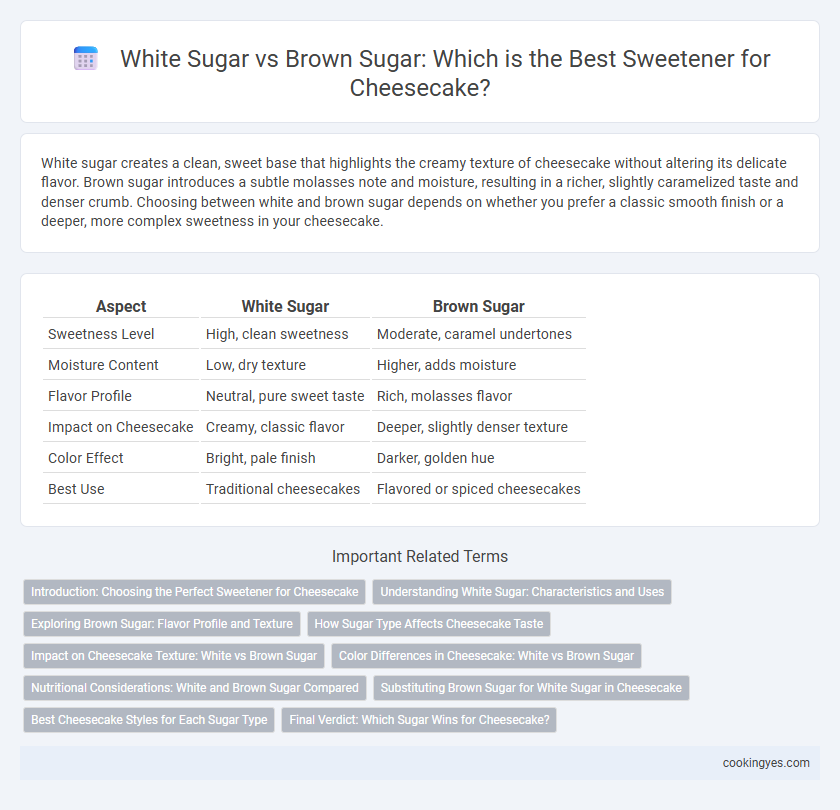White sugar creates a clean, sweet base that highlights the creamy texture of cheesecake without altering its delicate flavor. Brown sugar introduces a subtle molasses note and moisture, resulting in a richer, slightly caramelized taste and denser crumb. Choosing between white and brown sugar depends on whether you prefer a classic smooth finish or a deeper, more complex sweetness in your cheesecake.
Table of Comparison
| Aspect | White Sugar | Brown Sugar |
|---|---|---|
| Sweetness Level | High, clean sweetness | Moderate, caramel undertones |
| Moisture Content | Low, dry texture | Higher, adds moisture |
| Flavor Profile | Neutral, pure sweet taste | Rich, molasses flavor |
| Impact on Cheesecake | Creamy, classic flavor | Deeper, slightly denser texture |
| Color Effect | Bright, pale finish | Darker, golden hue |
| Best Use | Traditional cheesecakes | Flavored or spiced cheesecakes |
Introduction: Choosing the Perfect Sweetener for Cheesecake
White sugar provides a clean, neutral sweetness that highlights the creamy texture of cheesecake without overpowering its delicate flavors. Brown sugar adds a rich, caramel-like depth and moisture, enhancing the dessert's complexity and giving a subtle molasses undertone. Selecting between white and brown sugar depends on whether a lighter or more robust flavor profile is desired for the cheesecake.
Understanding White Sugar: Characteristics and Uses
White sugar, a refined sweetener made from sugar cane or sugar beets, offers a clean, neutral sweetness essential for achieving the classic creamy texture in cheesecakes. Its fine granules dissolve easily, providing consistent sweetness without altering the cheesecake's color or flavor profile. White sugar's purity allows the tanginess of cream cheese to shine, making it a preferred choice for traditional cheesecake recipes.
Exploring Brown Sugar: Flavor Profile and Texture
Brown sugar adds a rich, molasses-infused flavor to cheesecake, enhancing its depth with subtle caramel and toffee notes. Its higher moisture content contributes to a denser, creamier texture compared to the light and granulated feel white sugar provides. Using brown sugar can also result in a slightly darker crust and a more complex sweetness, elevating the overall cheesecake experience.
How Sugar Type Affects Cheesecake Taste
White sugar in cheesecake provides a clean, pure sweetness that allows the cream cheese flavor to stand out, creating a smooth and classic taste profile. Brown sugar adds a rich, molasses-like depth and subtle caramel notes, enhancing the complexity and giving the cheesecake a denser, more robust flavor. The choice between white and brown sugar influences the texture and moisture content as well, with brown sugar typically yielding a moister and chewier cheesecake.
Impact on Cheesecake Texture: White vs Brown Sugar
White sugar yields a classic smooth and creamy cheesecake texture due to its fine granules and pure sucrose content, promoting even sweetness and structure. Brown sugar, containing molasses, adds moisture and density, resulting in a slightly fudgier and more moist cheesecake texture. The choice between white and brown sugar significantly influences the baked cheesecake's firmness and richness, with brown sugar contributing to a denser crumb and white sugar producing a lighter, airier consistency.
Color Differences in Cheesecake: White vs Brown Sugar
White sugar produces a bright, creamy color in cheesecake due to its pure sucrose content, enhancing the dessert's classic appearance. Brown sugar contains molasses, which imparts a richer, caramel hue, resulting in a darker, more rustic cheesecake tone. The choice between white and brown sugar affects not only sweetness but also the visual appeal and perceived flavor depth of the finished cheesecake.
Nutritional Considerations: White and Brown Sugar Compared
White sugar and brown sugar both provide similar calorie amounts, with approximately 49 calories per tablespoon, but brown sugar contains trace amounts of minerals like calcium, potassium, and iron due to its molasses content. White sugar is more refined and has a higher glycemic index, which can cause quicker blood sugar spikes, while brown sugar's molasses content offers a slightly lower glycemic impact. Nutritional differences between the two are minimal, so the choice for cheesecake sweetening typically depends on desired flavor profile rather than significant health benefits.
Substituting Brown Sugar for White Sugar in Cheesecake
Substituting brown sugar for white sugar in cheesecake introduces a richer, more complex flavor due to the molasses content in brown sugar, which enhances the dessert's depth. Brown sugar also adds moisture, resulting in a creamier texture compared to the crisper finish from white sugar. When replacing white sugar, use a slightly reduced amount of brown sugar to balance sweetness and prevent excessive moisture, ensuring the cheesecake maintains its structural integrity.
Best Cheesecake Styles for Each Sugar Type
White sugar creates a classic, smooth texture ideal for New York-style and Japanese cheesecakes where a clean, sweet flavor is essential. Brown sugar adds a rich, caramel-like depth perfect for autumn-inspired or pumpkin cheesecakes, enhancing their warm, spiced profiles. Choosing between white and brown sugar directly impacts the cake's moisture, color, and overall flavor complexity.
Final Verdict: Which Sugar Wins for Cheesecake?
White sugar creates a smoother texture and cleaner sweetness that enhances the creamy flavor of cheesecake, while brown sugar adds a rich, caramel-like depth and moisture that can alter the traditional consistency. For classic cheesecake recipes, white sugar remains the preferred choice due to its ability to preserve the delicate balance of flavors and firm texture. Brown sugar works best in variations seeking a denser, more complex flavor profile but may compromise the iconic creamy mouthfeel.
White Sugar vs Brown Sugar for Cheesecake Sweetener Infographic

 cookingyes.com
cookingyes.com